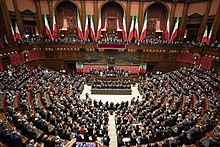Great Siege Monument
| Great Siege Monument | |
|---|---|
| Maltese: Il-Monument tal-Assedju l-Kbir | |
 The monument in 2017 | |
| Artist | Antonio Sciortino |
| Completion date | 8 May 1927 |
| Medium | Bronze |
| Movement | Neoclassical |
| Location | Valletta, Malta |
| 35°53′52.9″N 14°30′45.1″E / 35.898028°N 14.512528°E | |
The Great Siege Monument (Maltese: Il-Monument tal-Assedju l-Kbir), also known as the Monument to the Fallen of the Great Siege,[1] is a monument commemorating the Great Siege of Malta located in Valletta, Malta. It consists of three bronze figures symbolizing Faith, Fortitude (or Valour), and Civilization, standing on top of a granite base. The monument is the work of the sculptor Antonio Sciortino, and it was inaugurated on 8 May 1927.[2]
History
[edit]
The Great Siege Monument was sculpted by Antonio Sciortino in 1926, while he was in Rome. It was then cast in bronze using the lost-wax method, and the monument was inaugurated in Valletta on 8 May 1927.[3] During the inauguration, Chief Justice Arturo Mercieca delivered his speech in Italian, while the priest, philosopher and poet Anastasio Cuschieri delivered a speech in Maltese, both in the presence of the British Lieutenant-Governor, Sir Thomas Alexander Vans Best. This illustrated the language question and the political tension of the time.[1]
The monument is located in Great Siege Square (Maltese: Misraħ l-Assedju l-Kbir)[3] along Valletta's main road, Republic Street (Maltese: Triq ir-Repubblika) by the side of Saint John's Co-Cathedral.[4] The monument originally faced Auberge d'Auvergne,[5] which was replaced by the Courts of Justice building in the 1960s after the original building had been severely damaged in World War II.[4]
The Great Siege Monument appeared on three Maltese stamps issued in 1956, 1962 and 1972.[6] It also featured on the Maltese 50 cent coin that was minted from 1972 until it was replaced in 1986.[7]
The monument was restored between August[8] and September 2010.[4][9] It is listed on the National Inventory of the Cultural Property of the Maltese Islands.[3]
Since October 2017, the monument has been used as a makeshift memorial to journalist Daphne Caruana Galizia by members of her family and anti-government protesters.[10][11] For a while the tributes were removed on a daily basis by Government employees.[12] In 2020, a court decision found that the then Minister for Justice Owen Bonnici's orders to repeatedly clear the memorial were a violation of protestors' human rights for the freedom of expression.[13]
Description
[edit]

The Great Siege Monument is considered to be a work of Neoclassical sculpture,[3] exhibiting powerful simple lines which hint at Sciortino's avant-garde style. It has been called "one of the most emblematic sculptures on the island".[1] The statue consists of three bronze figures set on top of a granite base.[5][3] The positioning of the figures relates closely to Davide Calandra's relief La Glorificazione della Dinastia Sabauda at the Palazzo Montecitorio in Rome.[1]
The three figures are said to be allegorical representations of Faith, Fortitude (or Valour), and Civilization.[5] The male figure in the centre is described as Fortitude[3] or Valour,[14] and he is portrayed bare-chested and wearing a three-pointed crown and some armour, while holding a sword and a shield. There is a female figure on either side, with Faith on the left and Civilization on the right. Faith holds a papal tiara, while Civilization holds a mask of Minerva, the Roman goddess of Wisdom.[3]
References
[edit]- ^ a b c d Muscat, Mark Geoffrey (2016). "The Influence of Art Deco and Italian Futurism". Maltese Architecture 1900–1970: Progress and Innovations. Valletta: Fondazzjoni Patrimonju Malti. p. 43. ISBN 9789990932065.
- ^ Meilak, Daniel. "David versus Goliath and the Apotheosis of Malta: Romanticising the Siege of Malta during the Rise of Nationalism (1860-1939)". Melita Historica. XVII (1): 140–172. Archived from the original on 2019-06-06. Retrieved 2019-08-17.
- ^ a b c d e f g "Great Siege Monument" (PDF). National Inventory of the Cultural Property of the Maltese Islands. 28 December 2012. Archived from the original (PDF) on 7 January 2020.
- ^ a b c "Great Siege monument restored". Times of Malta. 7 September 2010. Archived from the original on 3 November 2017.
- ^ a b c Nelson, Nina (1978). Malta. London: Batsford. ISBN 0-7134-0941-X.
- ^ The JB Catalogue of Malta Stamps and Postal History (22 ed.). Sliema: Sliema Stamp Shop Publishers. 2014. pp. 18, 20, 31.
- ^ Said Malta Coin & Banknote Catalogue 2010. Valletta: Said International Ltd. 2010. p. 114. ISBN 9789990943269.
- ^ "FimBank sponsors restoration of Great Siege monument". Times of Malta. 5 August 2010. Archived from the original on 3 November 2017.
- ^ "Restored Great Siege Monument unveiled". The Malta Independent. 7 September 2010. Archived from the original on 3 November 2017.
- ^ "Candles for Daphne Caruana Galizia at Valletta memorial". Malta Today. 16 January 2018. Archived from the original on 16 January 2018.
- ^ Xuereb, Matthew (11 February 2018). "Valletta mayor says council has no power to decide on Caruana Galizia memorial". Times of Malta. Archived from the original on 12 February 2018.
- ^ Bonnici, Julian (2 December 2019). "Daphne Caruana Galizia Memorial Cleared Yet Again Less Than 24 Hours After Thousands Gathered In Valletta Calling For Immediate Resignations". Lovin Malta.
- ^ Borg, Jacob (1 February 2020). "'Minister's breach of rights is a throwback to Lorry Sant'". Times of Malta. Archived from the original on 25 May 2020.
- ^ "The Great Siege Monument in Valletta". Din l-Art Ħelwa. 6 October 2011. Archived from the original on 29 March 2017.
External links
[edit]![]() Media related to Great Siege Monument at Wikimedia Commons
Media related to Great Siege Monument at Wikimedia Commons

